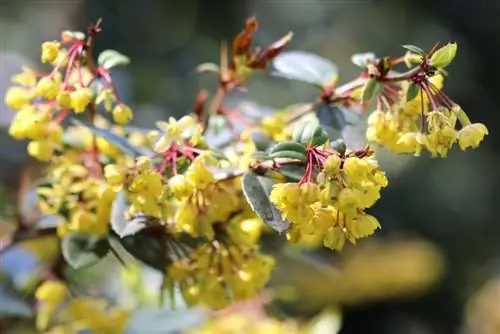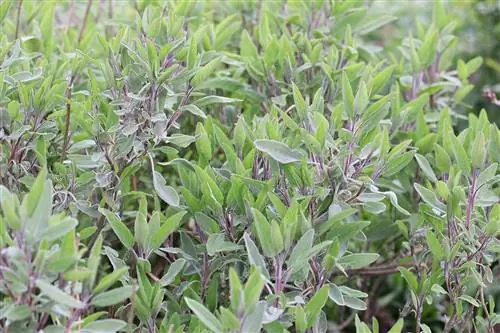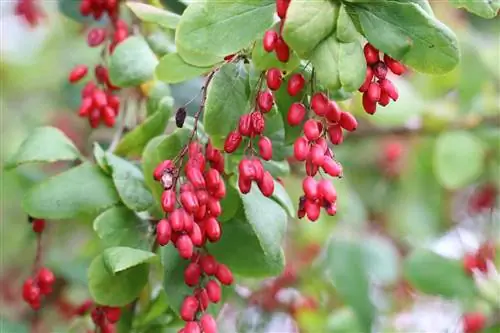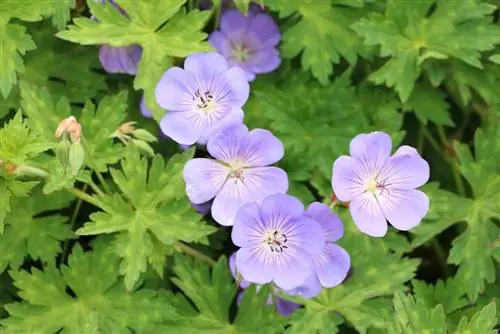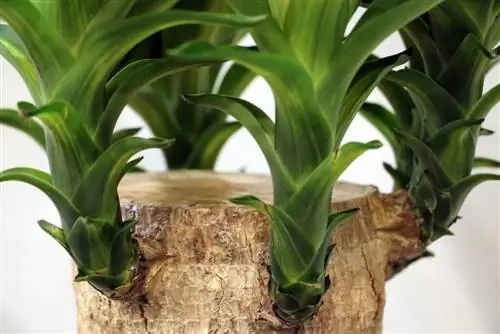- Author admin [email protected].
- Public 2023-12-17 03:39.
- Last modified 2025-01-24 12:45.
Barberries are one of the most species-rich woody genera, with 400 to 600 species. Although the plants are widespread, only two to four species are native to Europe. The best-known representative of the genus is the common barberry, which can also be found in the wild in this country. Forest edges, bushes or open meadows are the plants' preferred location.
Profile
- Genus: Barberries (Berberis)
- Family: Barberry family (Berberidaceae)
- Native species: Common barberry (Barberry vulgaris)
- Synonyms: Sourthorn, vinegar berry
- Growth habit: Shrub with thorns, perennial, overhanging, upright, spreading
- Growth height: 50 to 300 centimeters (depending on species and variety)
- Flowers: small, yellow, racemose inflorescences
- Flowering time: May to June
- Foliage / Leaves: elongated to ovoid, dark green, summer or evergreen
- Poisonous: all parts of the plant except the berries
Location
Barberries are hardy shrubs with sharp thorns. They can be planted as a hedge or solitary. The plants do not place any particular demands on the location. They also grow at higher altitudes. The ideal properties are:
- Sun to partial shade
- dry to moderately moist
Tip:
To protect yourself from the thorns, you should choose a location where you will not often come into contact with the plant.
Floor
As with the location, barberries don't place any great demands on the soil either. They actually grow on all types of soil. The plants feel particularly comfortable on soils that have the following properties:
- easy
- slightly calcareous
- pH value: neutral to slightly acidic
Plants
Young barberries are available from specialist retailers as pre-grown potted plants. In principle, the plants can be planted out on frost-free days at any time of the year. However, the optimal time for planting deciduous barberries is in autumn. This way the barberry can begin to sprout next spring. For evergreen species, spring and early summer are the ideal planting times. The growth rate is 15 to 20 centimeters per year.
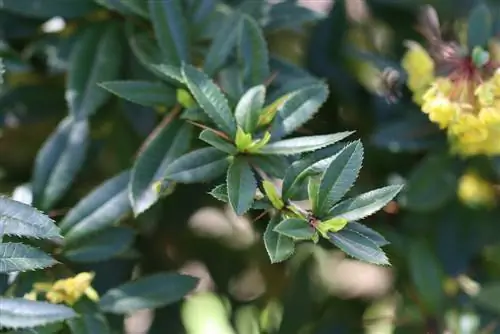
When planting barberry, it is important to protect your hands and arms from the sharp thorns. Follow these steps:
- Dig planting hole
- Planting depth: 10 centimeters
- shorten young barberry by a third in advance (better branching)
- Carefully lift the young plant out of the pot
- Remove roots from excess soil and loosen them up
- Insert plant
- Fill planting hole
- Press the soil lightly
- pour on
Tip:
A layer of bark mulch inhibits the growth of weeds. Therefore, considering the thorns, a layer of bark mulch is recommended.
Plant Neighbors
Barberries look best as solitary plants. Ground cover roses are suitable as underplanting for evergreen species. Crocuses, tulips and daffodils provide a colorful contrast in spring. If they are planted as a privacy hedge, you should plant a maximum of four to five plants per meter. To ensure that the individual plants in the hedge are particularly effective, you should combine different species or varieties with each other.
Care
Barberries are easy-care plants. Additional water or fertilizer is usually not necessary for planted specimens. Even annual pruning is not absolutely necessary for individual bushes.
Pouring
Barberries tolerate drought better than wet. Therefore, you only need to be supplied with additional water in dry summers or longer dry periods. The plants don’t like waterlogging at all. Therefore, you should create drainage on solid soil so that even heavy and continuous rain cannot harm the plants.
Fertilize
Regular fertilizer applications are not necessary for barberries. However, the plants enjoy a lime-containing fertilizer once a year.
Cutting
Barberries need to be trimmed regularly to keep their shape. This doesn't just apply to hedge plants. It is important that you protect your arms, legs and hands when cutting so that the sharp thorns do not cause injuries. Because of the thorns, you should not compost the clippings.
Cutting a barberry hedge
Since barberries tolerate pruning very well, regular trimming of the hedge should not cause any problems. The right time is for summer green barberries
- in late winter (February or March)
- on a frost-free day
Cut the barberry hedge from all sides so that it grows densely. You can freely choose the height of the hedge. If the hedge has to be shortened significantly, for example to significantly reduce the height, then even radical pruning won't affect the plants.
Dividing solitary shrubs
Since barberries grow very wide and sprawling, more pruning may be necessary for space reasons. If there is no space problem, then only those shoots that are growing too wide should be shortened. For optimal development of the plants, they should be wider at the bottom (near the ground) than at the top (in the crown area). The ideal time to cut deciduous barberries is:
in late winter (February or March) on a frost-free day
Tip:
If you put an old bed sheet and the bush before cutting, then no thorns will be left in the lawn or bed.
Evergreen barberries are best cut after flowering if you don't want to harvest the berries.
Wintering
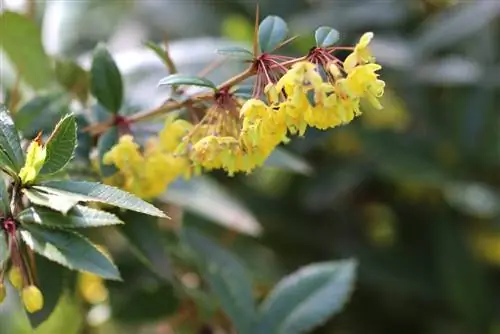
Planted shrubs do not need special winter protection.
Propagate
Cuttings and seeds are suitable for propagation, although propagation with cuttings is the easier option.
Propagate with cuttings
Ideally, you get cuttings from side shoots that grew in summer. Follow these steps:
- Cut cuttings with a length of seven to eight centimeters (protect hands and arms beforehand)
- Put in potting soil or place in a glass with water
- After rooting, place cuttings in the ground
- pour on
Note:
When propagated with cuttings, mother and daughter plants are identical.
Propagate with seeds
Seeds for propagation are obtained from the fully ripe barberry berries. Follow these steps:
- Harvesting berries (protecting hands and arms)
- Removing seeds
- Sprinkle seeds into small pots with potting soil
- water moderately
- plant young plants in the ground in spring
Note:
Since the plants are pollinated by insects, mother and daughter plants do not have to be identical.
Toxicity
All parts of the plant except the berries are poisonous. The poison concentration is particularly high in the roots. The main toxic active ingredients are:
- Berberine (1 to 3 percent)
- Jatrorhizin
- Palmatine
- Columbamin
- Iosotetrandin
- Magnoflorin
- Berbamin
Symptoms of poisoning are:
- Nausea
- Vomiting
- Diarrhea
- Kidney irritation
- Nephritis (kidney inflammation)
Harvest time
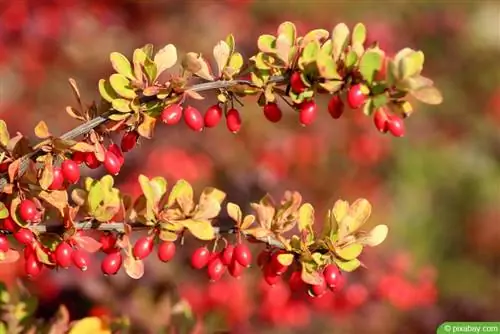
The berries, which are one centimeter long, can be harvested from August. The color of the fully ripe berries is red, purple or almost black, depending on the type. They are very acidic, but also very rich in vitamins. The fruits are used for cooking or for jam.
Diseases and pests
Barberries are very robust plants. Diseases are not yet known. There are no known animal pests that nest on the bushes. However, evergreen barberries are now more often attacked by the black weevil (beetle).
Mushrooms
The honey fungus is a danger to barberries. Since this edible fungus can destroy an entire hedge, you should immediately remove and dispose of affected parts of the plant. The cut parts are not allowed on the compost as the risk of renewed infestation is too great.
grain black rust
The barberry serves as an intermediate host for black rust (Puccinia graminis) in winter. Although this fungus does not harm barberries, it can cause major damage to grains. You can recognize this fungus by the orange-yellow to rusty-brown pustules on the underside of the leaves. Since there is currently no effective way to combat the fungus in grain, you should check with the responsible plant protection office before planting barberries to find out what conditions are attached to planting the bushes. You should also check the plants regularly for infestations. If you notice an infection, the affected parts of the plant must be removed and destroyed immediately.
Powdery mildew
Powdery mildew mainly affects deciduous barberries.

